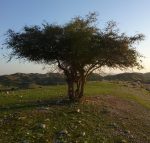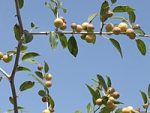 Christ’s thorn jujube is a shrub or small tree native to Africa, the Levant, and southern and western Asia where it grows in a variety of habitats including deserts, semi-desert washes, valley, and savannas as well as along the edges of ponds and riverbanks. A member of the buckthorn family, Rhamnacea, it is evergreen where the water supply is adequate, but deciduous in dry areas or during the dry season. Growing from a deep taproot and spreading lateral roots, the plants can grow up to 50′ tall but are usually considerably shorter, and have spreading grayish white branches that start low and rise to create a thick tangled canopy. The ovate-elliptic or suborbicular leaves are .4-2.4″ long and usually have 2 stipular spines at their base, one erect and .8″ long, the other recurved and .2-.3″ long. The axillary, greenish yellow flowers are slightly fragrant, less than .2″ across, and appear in the fall. The fruit is a red-yellow to yellow green round one seeded drupe .5-1″ across with an edible pulp. Christ’s thorn jujube is used from the wild for food, medicine, and materials, and is cultivated for its fruit, as a hedge and as a source of shade. The genus name, Zizphus, is derived from the Persian name zizfum. The specific epithet, spina-christi, is the Latin phrase meaning thorns of Christ because it is believed to be the plant from which Christ’s crucifixion crown was made. Photo Credit: Meincluded, Wikipedia
Christ’s thorn jujube is a shrub or small tree native to Africa, the Levant, and southern and western Asia where it grows in a variety of habitats including deserts, semi-desert washes, valley, and savannas as well as along the edges of ponds and riverbanks. A member of the buckthorn family, Rhamnacea, it is evergreen where the water supply is adequate, but deciduous in dry areas or during the dry season. Growing from a deep taproot and spreading lateral roots, the plants can grow up to 50′ tall but are usually considerably shorter, and have spreading grayish white branches that start low and rise to create a thick tangled canopy. The ovate-elliptic or suborbicular leaves are .4-2.4″ long and usually have 2 stipular spines at their base, one erect and .8″ long, the other recurved and .2-.3″ long. The axillary, greenish yellow flowers are slightly fragrant, less than .2″ across, and appear in the fall. The fruit is a red-yellow to yellow green round one seeded drupe .5-1″ across with an edible pulp. Christ’s thorn jujube is used from the wild for food, medicine, and materials, and is cultivated for its fruit, as a hedge and as a source of shade. The genus name, Zizphus, is derived from the Persian name zizfum. The specific epithet, spina-christi, is the Latin phrase meaning thorns of Christ because it is believed to be the plant from which Christ’s crucifixion crown was made. Photo Credit: Meincluded, Wikipedia
 Type: Deciduous or evergreen shrub or small tree
Type: Deciduous or evergreen shrub or small tree
Outstanding Feature: Thorns, fruit
Form: Spreading
Growth Rate: Moderate
Bloom: Very small, axillary greenish yellow flowers in fall
Size: Up to 50′ but usually smaller
Light:Full sun
Soil: Average, medium moist, well-drained, alkaline but tolerates much less; tolerates drought and saline conditions.
Hardiness: Zones 10-13
Care:Low maintenance
Pests and Diseases: None of signficance
Propagation: Seed
Outstanding Selections: Not applicable
Photo Credit: Wikipedia